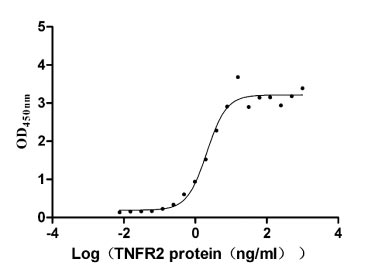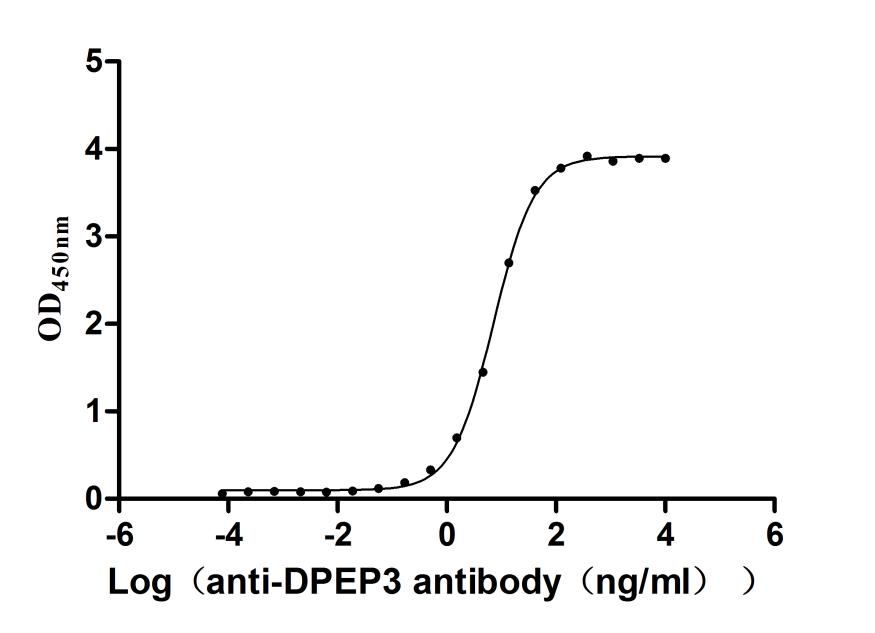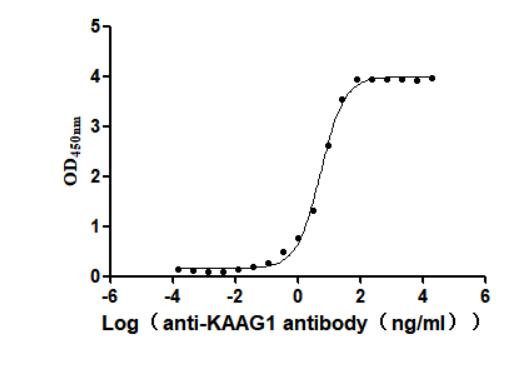Recombinant Human Pulmonary surfactant-associated protein A1 (SFTPA1)
-
货号:CSB-BP810281HU
-
规格:
-
来源:Baculovirus
-
其他:
-
货号:CSB-EP810281HU-B
-
规格:
-
来源:E.coli
-
共轭:Avi-tag Biotinylated
E. coli biotin ligase (BirA) is highly specific in covalently attaching biotin to the 15 amino acid AviTag peptide. This recombinant protein was biotinylated in vivo by AviTag-BirA technology, which method is BriA catalyzes amide linkage between the biotin and the specific lysine of the AviTag.
-
其他:
产品详情
-
纯度:>85% (SDS-PAGE)
-
基因名:Name:SFTPA1 Synonyms:COLEC4, PSAP, SFTP1, SFTPA, SFTPA1B
-
Uniprot No.:
-
别名:SFTPA1; COLEC4; PSAP; SFTP1; SFTPA; SFTPA1B; Pulmonary surfactant-associated protein A1; PSP-A; PSPA; SP-A; SP-A1; 35 kDa pulmonary surfactant-associated protein; Alveolar proteinosis protein; Collectin-4
-
种属:Homo sapiens (Human)
-
蛋白长度:full length protein
-
表达区域:21-248
-
氨基酸序列EVKDVCVGSP GIPGTPGSHG LPGRDGRDGL KGDPGPPGPM GPPGEMPCPP GNDGLPGAPG IPGECGEKGE PGERGPPGLP AHLDEELQAT LHDFRHQILQ TRGALSLQGS IMTVGEKVFS SNGQSITFDA IQEACARAGG RIAVPRNPEE NEAIASFVKK YNTYAYVGLT EGPSPGDFRY SDGTPVNYTN WYRGEPAGRG KEQCVEMYTD GQWNDRNCLY SRLTICEF
-
蛋白标签:Tag type will be determined during the manufacturing process.
The tag type will be determined during production process. If you have specified tag type, please tell us and we will develop the specified tag preferentially. -
产品提供形式:Lyophilized powder
Note: We will preferentially ship the format that we have in stock, however, if you have any special requirement for the format, please remark your requirement when placing the order, we will prepare according to your demand. -
复溶:We recommend that this vial be briefly centrifuged prior to opening to bring the contents to the bottom. Please reconstitute protein in deionized sterile water to a concentration of 0.1-1.0 mg/mL.We recommend to add 5-50% of glycerol (final concentration) and aliquot for long-term storage at -20℃/-80℃. Our default final concentration of glycerol is 50%. Customers could use it as reference.
-
储存条件:Store at -20°C/-80°C upon receipt, aliquoting is necessary for mutiple use. Avoid repeated freeze-thaw cycles.
-
保质期:The shelf life is related to many factors, storage state, buffer ingredients, storage temperature and the stability of the protein itself.
Generally, the shelf life of liquid form is 6 months at -20°C/-80°C. The shelf life of lyophilized form is 12 months at -20°C/-80°C. -
货期:Delivery time may differ from different purchasing way or location, please kindly consult your local distributors for specific delivery time.Note: All of our proteins are default shipped with normal blue ice packs, if you request to ship with dry ice, please communicate with us in advance and extra fees will be charged.
-
注意事项:Repeated freezing and thawing is not recommended. Store working aliquots at 4°C for up to one week.
-
Datasheet :Please contact us to get it.
相关产品
靶点详情
-
功能:In presence of calcium ions, it binds to surfactant phospholipids and contributes to lower the surface tension at the air-liquid interface in the alveoli of the mammalian lung and is essential for normal respiration. Enhances the expression of MYO18A/SP-R210 on alveolar macrophages.; (Microbial infection) Recognition of M.tuberculosis by dendritic cells may occur partially via this molecule. Can recognize, bind, and opsonize pathogens to enhance their elimination by alveolar macrophages.
-
基因功能参考文献:
- This study is suggestive that the PCR (polymerase chain reaction) for the detection of coa, mecA, and spa gene is a fast, accurate, and valuable diagnostic tool. PMID: 30074012
- TGF beta markedly decreased expression of SP-A, SP-B, SP-C, fatty acid synthase, and the phospholipid transporter ABCA3. However, TGF beta increased protein levels of SP-D with little change in mRNA levels. PMID: 29621540
- this study shows that concentrations of SP-A are associated with polarization of macrophages in pleural effusions of non-small cell lung cancer PMID: 29111316
- the SPA and SPD levels in EBC were correlated with lung function, which contributed to COPD diagnosis. PMID: 28791362
- Data (including data from studies using transgenic/knockout mice) suggest that surfactant protein A1 (SPA1) interferes with EGF binding to EGFR in pulmonary alveoli cell lines; SPA1 directly binds extracellular domain of EGFR; binding of SPA1 to EGFR appears to be different from binding of SPD to EGFR; binding of SPA1 to EGFR does not suppress EGF-induced phosphorylation of EGFR or cell proliferation. PMID: 28972165
- This review intends to provide a current overview of the genetics, structure and extra-pulmonary functions of the surfactant collectin proteins. PMID: 28351530
- The SFTPA1 haplotype comprising rs17881720-A and rs17879335-G was a resistance factor while the haplotype comprising rs1914663-T and rs1059225-G was found to be a susceptibility factor to tuberculosis in Han Chinese population. PMID: 27012150
- SP-A transiently enhances the basal protein expression of CHC and alpha-adaptin. PMID: 26771574
- the presence of SP-A1 allows pulmonary surfactant to adopt a particularly favorable structure with optimal biophysical properties PMID: 27508436
- SP-A1 6A4 and SP-A2 1A5 genetic variants may influence the susceptibility to respiratory distress syndrome in late-preterm infants, independently of the effect of other perinatal factors. PMID: 27835691
- Direct interaction between SP-A or SAP01 and human BD-3 seemed to be responsible for the inhibitory effects on chemotaxis of mast cells. PMID: 28188794
- SP-A (+186A/G) and SP-B (1580C/T) polymorphisms are strongly associated with the risk of respiratory distress syndrome (RDS) in preterm infants. Notably, reduced serum SP-A levels were correlated with a high risk of RDS and may serve as novel biomarkers for RDS detection and monitoring. PMID: 28011976
- Surfactant protein A levels differed among idiopathic pulmonary fibrosis, pulmonary sarcoidosis and chronic pulmonary obstructive disease. PMID: 27758987
- Differences were found regarding SPA and pro-SPB expression in the vast majority of subjects: in some lungs, SPA was more expressed whereas in others pro-SPB showed an higher degree of immunoreactivity. The expression of both surfactant proteins was not strictly correlated with gestational age. PMID: 27734990
- Study identifies SFTPA1 as a gene involved in familial idiopathic interstitial pneumonia and shows that altered SP-A1 expression is associated with a large spectrum of phenotypic pulmonary manifestations ranging from severe respiratory insufficiency occurring early in life to lung fibrosis and cancer in adult patients. PMID: 26792177
- These results suggested that the measurement of SPA levels in the exhaled breath condensate may serve as a method for monitoring airway obstruction in patients with chronic obstructive pulmonary disease. PMID: 26707652
- Human and murine data together indicate that SP-A, SP-D and MBL are synthesized in early gestational tissues, and may contribute to regulation of immune response at the feto-maternal interface during pregnancy. PMID: 26603976
- SP-A in exhaled particles from small airways may represent a promising non-invasive biomarker of disease in chronic obstructive pulmonary disease patients. PMID: 26656890
- In this study, the loci and haplotypes associated with pulmonary tuberculosis (PTB)were found mostly to be located in the SFTPA2 gene, suggesting that the effects of the SFTPA2 gene on PTB are stronger than those of SFTPA1. PMID: 24984162
- Data suggest that that surfactant protein A(SP-A) levels may be important to maintain surfactant function in the presence of high cholesterol within surfactant. PMID: 25522687
- SP-A modulates lung immune system in the area of non-infectious lung diseases such as acute and chronic pulmonary fibrosis and lung cancer. PMID: 24705741
- 12 of which predicted to bind SP-A 3'UTRs. PMID: 25058539
- This study shows that changes occur in the alveolar macrophage proteome in response to a single in vivo treatment with exogenous SP-A1 and/or SP-A2. PMID: 24954098
- SP-A1 transcripts, which in turn negatively affect SP-A1 translation, possibly affecting SP-A1/SP-A2 ratio, with potential for clinical implication. PMID: 25326576
- In this review, we highlight the associations of eosinophilic lung diseases with SP-A and SP-D levels and functions. PMID: 24960334
- sequence variability at the 3'UTR of SFTPA1 and SFTPA2 gene variants differentially affects miRNA regulation of gene expression. PMID: 24793167
- Results show that cloned surfactant-associated protein A (SPA) gene promoter had specific transcriptional activity in SPA high expression cells. PMID: 24939295
- The result suggested that polymorphism of aa62 (CCA/CCG, rs1136451) of SP-A may be associated with the susceptibility to COPD in Xinjiang Uighurs. PMID: 22528218
- The current meta-analysis indicates that common polymorphisms in the SP-A gene may contribute to increasing susceptibility to COPD, especially among Asian populations. PMID: 24093802
- SP-A gene polymorphism is associated with kidney graft rejection. PMID: 24007361
- SP-A inhibited lung cancer progression by recruiting and activating natural killer cells via controlling the polarization of tumor-associated macrophages. PMID: 23499372
- The obtained results suggested that in vitro approach can be used to study pulmonary toxicity as long as the applied in vitro model mimics closely the complexity of in vivo situation. PMID: 22769972
- Cat S may participate in the pathophysiology of cystic fibrosis by weakening the antibacterial activity of SP-A. PMID: 23707200
- The aim of this report is to describe the genetic complexity of the SFTPA1 and SFTPA2 genes, as well as to review regulatory mechanisms that control SP-A expression in humans and other animal species.[review] PMID: 23069847
- elevated expression in nasal mucosa in chronic rhinosinusitis with polyps PMID: 23406594
- Surfactant Protein-A, like other host defense molecules in the reproductive tract, appears to be regulated by gonadal hormones. PMID: 22672628
- Surfactant protein A associated with respiratory distress syndrome in Korean preterm infants: evidence of ethnic difference. PMID: 23038062
- Lipoteichoic acid can increase SP-A synthesis in human alveolar type II epithelial cells through sequentially activating the MEK1-ERK1/2-NF-kappaB-dependent pathway PMID: 23031213
- Gln238Lys missense variant of exon 6 in the SFTPA1 may have potential susceptibility in the development of IPF, which was shown in patients with sporadic IPF with a statistically higher frequency. PMID: 22884059
- Surfactant protein-A suppresses eosinophil-mediated killing of Mycoplasma pneumoniae in allergic lungs PMID: 22384248
- review focuses on published association studies of surfactant proteins A and D genetic polymorphisms with respiratory, and non-respiratory diseases in adults, children, and newborns [review] PMID: 22201752
- SP-A protects lung epithelium from tissue injury caused by BD3 PMID: 22418431
- Surfactant protein A is defective in abrogating inflammation in asthma. PMID: 21784968
- genetic variants of the surfactant protein A1 confer a protective phenotype against severe acute respiratory syncytial infection PMID: 21601013
- Both nasal polyps and nasal mucosa expressed SP-A mRNA and protein, but the expression was stronger in nasal polyps. PMID: 20873544
- The expression of SP-A in allergic rhinitis and nasal polyps was dramatically higher than that in controls. PMID: 19894557
- findings suggest that Suv39H1 and Suv39H2 are key hypoxia-induced methyltransferases; their decline in fetal lung during late gestation is critical for epigenetic changes resulting in the developmental induction of SP-A PMID: 21402781
- Paucity of immunohistochemical SP-A expression in alveolar epithelial cells in diseased areas may predict a worse prognosis for patients with idiopathic interstitial pneumonias. PMID: 21435274
- High SPA-1 is associated with invasion and metastasis of prostate cancer. PMID: 21251160
- SP-A likely plays a critical role in regulating prostaglandin production within the uterus, culminating at term in decidual activation and the onset of labor. PMID: 21270323
显示更多
收起更多
-
相关疾病:Pulmonary fibrosis, idiopathic (IPF); Respiratory distress syndrome in premature infants (RDS)
-
亚细胞定位:Secreted, extracellular space, extracellular matrix. Secreted, extracellular space, surface film.
-
蛋白家族:SFTPA family
-
数据库链接:
HGNC: 10798
OMIM: 178500
KEGG: hsa:653509
STRING: 9606.ENSP00000397082
UniGene: Hs.535295
Most popular with customers
-
Recombinant Macaca fascicularis Angiotensin-converting enzyme (ACE2), partial (Active)
Express system: Mammalian cell
Species: Macaca fascicularis (Crab-eating macaque) (Cynomolgus monkey)
-
Recombinant Human Lymphotoxin-alpha (LTA) (Active)
Express system: Mammalian cell
Species: Homo sapiens (Human)
-
Recombinant Human Prolactin receptor (PRLR), partial (Active)
Express system: Mammalian cell
Species: Homo sapiens (Human)
-
Recombinant Human Intestinal-type alkaline phosphatase (ALPI) (Active)
Express system: Mammalian cell
Species: Homo sapiens (Human)
-
Recombinant Macaca fascicularis Trophoblast glycoprotein (TPBG), partial (Active)
Express system: Mammalian cell
Species: Macaca fascicularis (Crab-eating macaque) (Cynomolgus monkey)
-
Recombinant Human Dipeptidase 3(DPEP3), partial (Active)
Express system: Mammalian cell
Species: Homo sapiens (Human)
-
Recombinant Human Kidney-associated antigen 1(KAAG1) (Active)
Express system: Baculovirus
Species: Homo sapiens (Human)



















